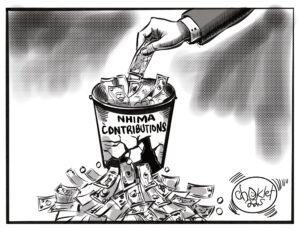The Organization for Economic Cooperation and Development (OECD)estimates that Africa loses USD 50 billion annually to tax evasion. In some place the figure is much higher; for example, the United Nations Economic Commission for Africa places the figure at USD 100 billion annually.
Tax evasion and avoidance pose a huge threat to development by widening the financing gap. Tax evasion involves taking illegal steps to avoid paying taxes, such as not declaring income. Tax avoidance on the other hand is defined as the legal measures employed to use a tax regime to pay the least possible tax such as setting up corporate residence in tax havens and claiming on deductions. The financing gap refers to the difference between the amount needed to achieve Sustainable Development Growth and actual government revenue. The United Nations Conference on Trade and Development (UNCTAD) estimates that there is a financing gap of USD210 billion for crucial government initiatives, such as infrastructure development, food security, healthcare and education. Critical to implementing an effective development agenda is an efficient tax policy and administration, but more importantly effective tax enforcement.
This article explores the main drivers of tax evasion and avoidance in Zambia and assesses the government’s tax enforcement capacity.
Multinational companies involved in resource extraction are particularly effective at tax avoidance and in some cases tax evasion. Mineral and oil extraction companies, account for total annual losses of up to 6 percent of African GDP in Sub-Saharan Africa (Borgen:2019).
According to the Zambia Revenue Authority (“ZRA”) the main sources of tax evasion include:
(i) repatriation of proceeds from mining companies in Zambia to offshore jurisdictions while declaring losses in Zambia.
(ii) false accounting techniques by corporations to reduce tax obligations;
(iii) non-declaration of exportation of resources; and
(iv) under valuation of precious stones and base metals that are exported to foreign jurisdiction.
The key determinants in effective tax compliance include:
(i) the tax payer’s willingness and tolerance to risk; and
(ii) the size of the penalties imposed when caught evading
(iii) the capacity of the revenue institutions to detect non-compliance and enforce tax legislation.
The capacity of a government’s tax enforcement is determined largely by information constraints. Governments typically conduct costly audits in order to verify economic outcomes. Case in point, in May 2009 the ZRA undertook an audit of Mopani Copper Mine Plc (“Mopani”). The audit exercise entailed a tax audit of Mopani’s costs, revenue and transfer pricing practices. The tax audit was centered mainly on transfer pricing conduct between Mopani and its holding company, Switzerland based, Glencore International AG (“GAIG”) covering the charge years 2006/07; 2007/08; and 2008/09.
The audit flagged irregularities in respect of related party transactions between Mopani and GAIG, particularly whether the transactions were at arm’s length. The ZRA concluded that Mopani had under-priced copper sold to GIAG, thus reducing its taxable income and hence its tax liability. Theaudit revealed that the prices of copper sold to GIAG were significantly lower than those of similar sales to third parties such as ZAMEFA and Chambeshi and as such. The total tax liability for the 2008/2009 charge year was assessed at ZMK 311,113,798.38 which led to a lengthy dispute between Mopani and the ZRA.
In May of 2020 the Supreme Court of Zambia ordered Mopani Copper Mining Plc (Mopani) to pay theZambia Revenue Authority (ZRA) an additional tax of ZMW 240 million (approximately USD 11,5 million). In its ruling the Supreme Court stated that this form of transfer pricing between multinational corporations and their African subsidiaries is typical of the tax avoidance practices employed by corporate taxpayers primarily to reduce their tax liabilities. It further stated that this dispute is archetypal of the problem posed to the fiscus of many developing economies by multinational corporations engaged in the extractive industry. It also highlights the inadequacy of institutional capacity to deal effectively with such corporations; exposes yearning gaps in the much-needed expertise to gather and interpret essential technical information for enhanced tax revenue collection from multinational corporations.
From this judgment and the preceding due process,it is evident that a critical determinant in the Government’s tax enforcement capacity is the tax enforcement technology and the role of digitalization. It is argued that digitalization can help inform information constraints by providing better ways for revenue authorities to verify economic outcomes of taxpayers and also by making it easier for Governments to link existing information in various parts of the tax system to detect evasion and avoidance (IMF: 2018).
ZRA has undergone a series of reforms to enhance its institutional capacity. In the follow up article, I examine some of these reforms and identify opportunities that exist at regional and international levels to develop Exchange of Information (EOI) systems within the context of digitalization.
About the Author
Chileshe G. Mange is a Researcher at CTPD, an Advocate of the High Court for Zambia and a part-time tutor with the University of Zambia.

























One Response
Losing 6% of GDP is significant but insufficient to justify extreme corrective measures. Above all, there is no need to apply personal sentiments to technical problems. Use, rely and depend on calculators and algorithms. Tax offenders need to be treated equally and equitably. Tax offenses do not justify irrational and illogical interventions. To obtain correct figures for exports, start by counterchecking at points of origin (farms, factories or mines). Then countercheck at customs control points (airports or land border immigration and customs). Next, countercheck point of landing in recipient countries (Heathrow, Frankfort or CDG). Lastly, countercheck at points of sale. In short, it is not possible to slaughter ten million heads of cattle per annum out of an abattoir with a capacity of ten thousand heads of cattle. If the business is making heavy losses, then feel free to get rid of it. A willing buyer will come forward and turn it around.